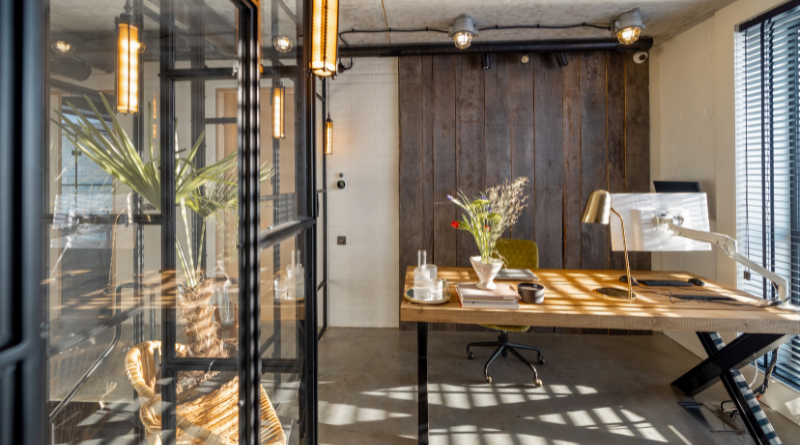
Territoriality
‘A man’s home is his castle.’ (Anon)
In the original context the term ‘Territoriality’ is defined in the 2003 Dictionnaire de la Geographie as the “expression of the multidimensionality of territorial being” and is linked to geopolitical and socio-spatial theory.
From the Franco-Swiss and Italian thinking and perspective of Claude Raffestin (who wrote on, and influenced, the geographical perspectives on the topic in these and other countries) territoriality is associated with geographic boundaries between countries or territories that include an individual’s or a society’s multi-dimensional link to a defined territory that a boundary marks out.
Specifically, it is the space, power, and sociospatial relations that the boundary holds, and where space is “socially appropriated… as the object of social practice, knowledge, and intentions… space becomes territory within any social relation of communication” *.
In understanding the impact of hybrid and remote work, this term is borrowed here to help explain the theory behind the physical and psychological impact of carving out space in the home for the exclusive use of workplace activities – thereby denying the individual and their families that space to use for their own purposes and enjoyment.
In this context ‘Territoriality’ is used to represent the surrendering of ‘home geographic estate’ (funded by the employee) for the sole use of work activities (for the benefit of the employer).
In a metaphorical context our ‘work territory’ has been extended beyond the invisible boundary that exists when traveling between home and work.
This invasive digital intrusion of workplace communications had already started to take place with the entrenchment of normative behaviour of checking work emails and messages in the evening, weekend and on holiday. Once we started to carve our office space at home since March 2020, office equipment and space now occupies part of our home environment in a more complex and definitive way.
How we’re giving up part of our home geography to workplace activities.
For those workers who still have their own allocated desk in an office, there is a tendency to personalise this space to make it a little more ‘home away from home’. For others whose workplace norm consists mostly of hot-desking and hybrid working there is no option for workspace personalisation.
As we spend more time remote and hybrid working, we’re tending instead to replicate our office technology at home – either purchased for us by our employer or by us for work purposes (possibly to maximise our productivity and reduce the risk of a comparative loss of productivity).
This is over and above the additional costs of office furniture, stationery and equipment, connectivity, utilities, etc.
Whatever our remote or hybrid set-up is, we’re creating dedicated space in our homes to make that space ‘work away from work’.
And not everyone has dedicated work space – often a kitchen/dining table or sofa is shared with a partner, children or housemates.
The financial cost of giving up home territory to work activities.
Although some companies have insisted on either all or most employees returning to on-premises work, there are some who have more fully embraced the remote and hybrid model and reduces the physical office space, resulting in estate cost savings.
Regardless of the savings a company is making in less people coming into the office, those who have set up a remote or hybrid work station at home have often needed to make a financial sacrifice to do so.
For these workers, the cost for conducting business on behalf of the company has shifted, to some degree, from the employer to the employee.
The psychological and emotional cost of giving up home territory to work activities.
For those companies who have moved mostly to a remote / hybrid model – allowing for the reduction of business estate costs – the geographical cost for conducting business has shifted from the employer to the employee.
In a metaphorical context our ‘work territory’ has been extended beyond the invisible boundary to become an invasive digital intrusion of workplace communications, equipment and office space that now occupies part of our home environment in a more complex and definitive way.
In a November 2020 British Psychology (the Digest) article, Abigail Marks of Stirling University in the Working@Home project was noted as saying ‘this new world order, where the home becomes a multi-occupational, multi-person workplace … not only challenges boundaries, but also conceptions of the domestic space’.
Is it a good thing that the ‘domestic space’ is being challenged, or should the domestic space be a place of sanctury and safety from the excesses of knowlegeand office based work?
Whether we have a dedicated office space at home, set up our laptop at our kitchen table or sofa, or just answer our work emails on our personal mobile device. in many ways, ‘work’ has taken mental, emotional and physical space and place in our homes.
This ‘home territory’ is now being used for the purposes and profit of the organisation, often to the detriment of the worker and their family’s lived space.
Work follows the worker home.
Prior to the turn of the century and the introduction of Blackberries into the working life, leaving the office and returning home meant an escape from the worries and demands of work.
Those who study the changes on digital technology has on school-place bullying talk about how, prior to the ubiquitous possession and use of smartphones by the young, bullying remained mostly in the school environment. In some cases, the bullying continued on the journey home. Once the child entered their home, they (generally) had a safe space where they could escape from the constant emotionally, physical and psychological torment of bullying. Children are now denied that escape. The cyber-bullying follows them into the home and into their bedroom. It is pervasive and intrusive – with the potential for further aggressive exposure all day and all night.
This is not dissimilar to the invasiveness of workplace technology. There is no longer an escape from the constant communication, demands and stress of the workplace. It has followed us into the house and is pervasive all day and all night.
The work laptop and phone at home reminds us of that email, that project, that request we still need to deal with. Our minds and emotions idle in a state of hyper-vigilance that used to be set aside and left behind at the end of the work day.
Now we live on constantly on alert, anticipating what might be next. Home is no longer a physical and psychological escape and safe-haven from the relentless messages and demands of work that it once was.
What this means for us and our boundaries.
Our self-identity, and how we interact with those in our home and community is often wrapped up in the sociospatial world we find ourselves in.
If you live in England, for example, there is a good chance you will support English sporting teams.
We talk about ‘Londoners’, or ‘Liverpudlians’, or ‘The Scottish’ as though everyone who live there are all generic.
Just like the spatial definitions of geographic country, county and town boundaries, the geographic perimeter around our house is an important delineation of who we are and a protected space by legal precedent within English common law – in which a person cannot physically enter your home unless invited.
This basic right can often give us a sense of place and security where we are free to let down our guard and be ourselves.
It’s where we do family, relationships, hobbies, entertainment and relaxation.
Virtually in our homes.
The mass shift to remote working that launched office workers into hybrid working lives began with our colleagues, bosses and clients being virtually invited into our home lives during working hours.
In research conducted by Remote Working Research Group, based at Stanford University, on Zoom Fatigue found that there were four reasons why we get so tired from spending time in video meetings. The first of these is around the constant eyeball contact, having to speak when everyone’s eyes are on you and (for the purposes on of this discussion) around professional infringement of personal space.
We will often have our screens within a short reaching distance from us, sometimes even closer. Subconsciously, our brain does not differentiate between the distance of a face in real life and that of a virtual face.
The impact of work into home intrusion.
Having the faces of colleagues and strangers infringing on the personal space that we normally reserve for family and close friends can be exhausting as we mentally attempt to create a more comfortable distance between them and us.
Allowing colleagues and strangers into your home via your video camera has a few other unintended consequences:
- During the pandemic, a number of workers, seeing the struggle working parents had with juggling work and home responsibilities experienced greater levels empathy towards these colleagues.
- However, colleagues and strangers were given the opportunity to peer (almost uninvited) into a space that a number of workers aren’t generally comfortable allowing. There are many colleagues, bosses and clients we never invite into our homes, , but wheven with a bdigitised background during video meetins, the worker may feel as though the others are actially in their home. This may trigger social comparison and feeling judged by others. and generally do not physically invite them into.
- Although many who still engage in remote or hybrid working have made inroads into providing good video backdrops for conference calls (or blur their background when they aren’t able to do so), there is still a sense of strangers virtually entering into the domesticity of your home environment – with all the background noises and non-business interruptions that this ensures.
There are a few questions that we ought to be asking (and probably answering) from a psychological perspective:
- How much of this additional ‘allowing in’ of business reduces the psychological and emotional territoriality of our home-based boundary?
- As a consequence, have we psychologically and emotionally given over or allowed more of work to intrude into our personal space because we have already allocated more geographical physical space to work tasks?
- Does where we allocate our working tools within our house make a difference to how much of our psychological and actual time we give to work outside of working hours – i.e. if our working tools are located in the main living room, does this mean that we are psychologically more entrenched in our work already and if we have a room sectioned off within the house, does this still ‘give us permission’ to wander into other areas of our home with our laptop to work – even though we already have an area geographically sectioned off for work?
Notes:
- The opening quote: ‘A man’s home is his castle’ can probably be dated to a legal precept in England (since at least the 17th century) that no one may enter a home, which would typically then have been in male ownership, unless by invitation. This was established as common law by the lawyer and politician Sir Edward Coke (pronounced Cook), in The Institutes of the Laws of England, 1628:”For a man’s house is his castle, et domus sua cuique est tutissimum refugium [and each man’s home is his safest refuge].” What was meant by ‘castle’ was defined in 1763 by the British Prime Minister with an admirable selection of names to choose from – William Pitt, the first Earl of Chatham, also known as Pitt the Elder:”The poorest man may in his cottage bid defiance to all the forces of the crown. It may be frail – its roof may shake – the wind may blow through it – the storm may enter – the rain may enter – but the King of England cannot enter”’. You can read more about this phrase here.
- * This definition and explanation is from ‘Thinking through territoriality: introducing Claude Raffestin to Anglophone sociospatial theory‘ by Francisco R Klauser – published in Environment and Planning D: Society and Space 2012, volume 30, pages 106 – 120.




